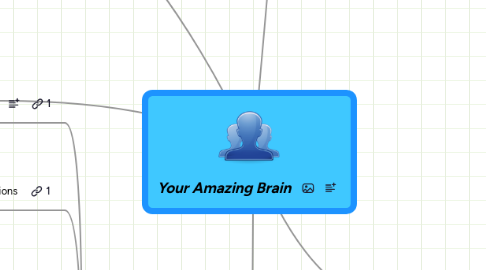
1. Neuron
1.1. Functions
1.1.1. transmits information
1.2. Etymology
1.2.1. nerve cell with appendages
1.3. Location
1.4. Structures
1.4.1. Glial Cells
1.4.1.1. Functions
1.4.1.1.1. physical support for neurons
1.4.1.1.2. transport nutrients to neurons
1.4.1.1.3. consume parts of dead neurons
1.4.1.1.4. regulate extracellular space
1.4.1.1.5. phagocytosis
1.4.1.2. Etymology
1.4.1.2.1. glue
1.4.1.3. Location
1.4.2. Dendrite
1.4.2.1. Functions
1.4.2.1.1. conduct electrochemical stimulation to other neural cells
1.4.2.2. Etymology
1.4.2.2.1. tree
1.4.2.3. Location
1.4.3. Neurotransmitter
1.4.3.1. Functions
1.4.3.1.1. middlemen for neurons
1.4.3.1.2. carry info across synaptic gap for neurons
1.4.3.2. Etymology
1.4.3.2.1. receiver
1.4.3.3. Location
1.4.4. Synapse
1.4.4.1. Functions
1.4.4.1.1. pass on directions from neurons to cells
1.4.4.2. Etymology
1.4.4.2.1. conjunction
1.4.4.3. Location
1.4.5. Axon
1.4.5.1. Functions
1.4.5.1.1. contacts other cells
1.4.5.1.2. takes info away from other cells
1.4.5.2. Etymology
1.4.5.2.1. measurement
1.4.5.3. Location
2. Brain Stem
2.1. Structures
2.1.1. Pons
2.1.1.1. Functions
2.1.1.1.1. sleep
2.1.1.1.2. respiration
2.1.1.1.3. swallowing
2.1.1.1.4. bladder control
2.1.1.1.5. hearing
2.1.1.1.6. equilibrium
2.1.1.1.7. taste
2.1.1.1.8. eye movement
2.1.1.1.9. facial expressions
2.1.1.1.10. facial sensations
2.1.1.1.11. posture
2.1.1.2. Etymology
2.1.1.2.1. bridge
2.1.1.3. Location
2.1.2. Medulla Oblongata
2.1.2.1. Functions
2.1.2.1.1. breathing
2.1.2.1.2. heart rate
2.1.2.1.3. blood pressure
2.1.2.1.4. balance
2.1.2.1.5. reflex centers
2.1.2.2. Etymology
2.1.2.2.1. middle
2.1.2.3. Location
2.2. underneath the limbic system
2.3. Responsible for basic vital functions
2.4. Location
3. Cerebellum
3.1. Etymology
3.1.1. small brain
3.2. Functions
3.2.1. motor control
3.2.2. language
3.2.3. attention
3.2.4. emotion regulation
3.3. Location
3.4. Limbic Region
3.4.1. Structures
3.4.1.1. Hippocampus
3.4.1.1.1. Functions
3.4.1.1.2. Etymology
3.4.1.1.3. Location
3.4.1.2. Hypothalamus
3.4.1.2.1. Functions
3.4.1.2.2. Etymology
3.4.1.2.3. Location
3.4.1.3. Thalamus
3.4.1.3.1. Functions
3.4.1.3.2. Etymology
3.4.1.3.3. Location
3.4.1.4. Amygdala
3.4.1.4.1. Functions
3.4.1.4.2. damaged in binge drinking
3.4.1.4.3. Etymology
3.4.1.4.4. Location
3.4.2. referred to as the "emotional brain"
3.4.3. found burried in the Cerebellum
3.4.4. Etymology
3.4.4.1. edge
3.4.5. Location
4. Works Cited
5. Cerebrum
5.1. Corpus Callosum
5.1.1. Functions
5.1.1.1. facilitates communication between two hemispheres of cerebrum
5.1.2. Etymology
5.1.2.1. body
5.2. Cortex
5.2.1. Etymology
5.2.1.1. outer shell
5.2.2. Functions
5.2.2.1. memory
5.2.2.2. thought
5.2.2.3. perception
5.2.2.4. attention
5.2.2.5. language
5.2.3. Location
5.2.4. Structures
5.2.4.1. Prefrontal Cortex
5.2.4.1.1. Etymology
5.2.4.1.2. Functions
5.2.4.1.3. Location
5.2.4.2. Temporal Lobe
5.2.4.2.1. Etymology
5.2.4.2.2. Functions
5.2.4.2.3. Location
5.2.4.3. Occipital Lobe
5.2.4.3.1. Etymology
5.2.4.3.2. Functions
5.2.4.3.3. Location
5.2.4.4. Parietal Lobe
5.2.4.4.1. Functions
5.2.4.4.2. Etymology
5.2.4.4.3. Location
5.3. Functions
5.3.1. controls all voluntary actions
5.4. Etymology
5.4.1. brain
